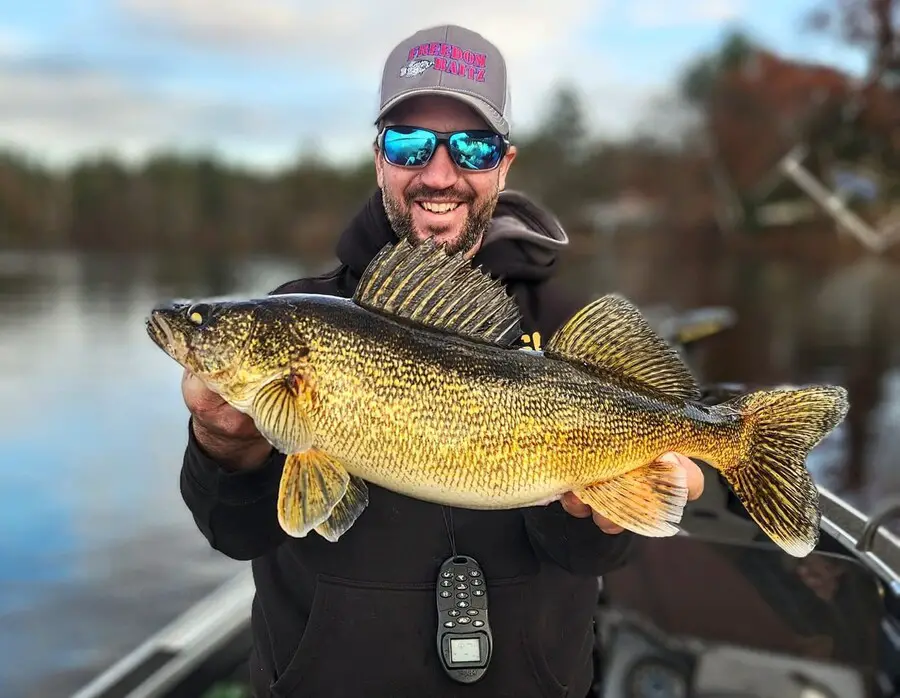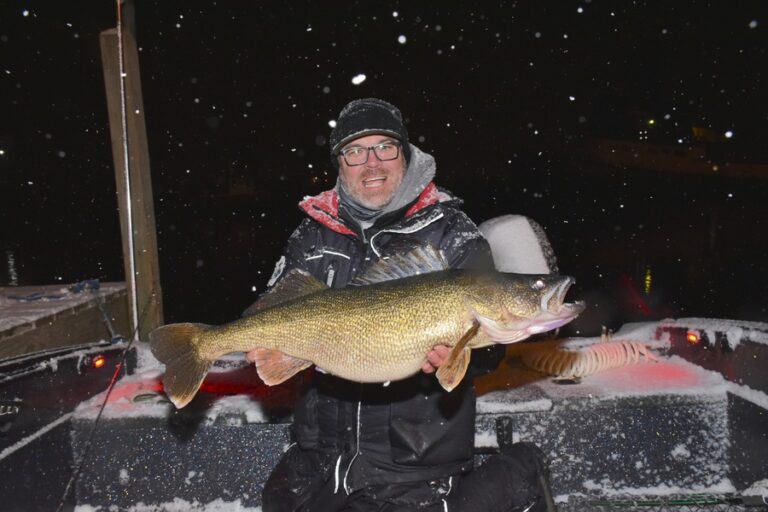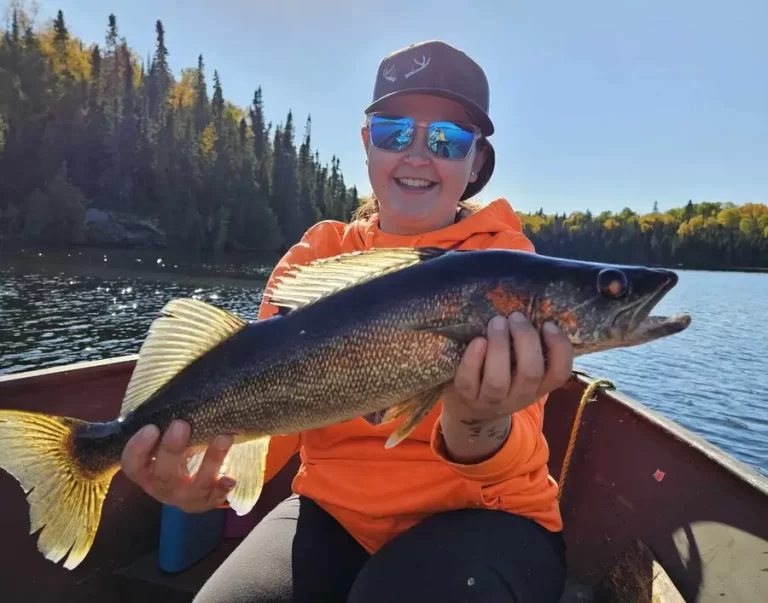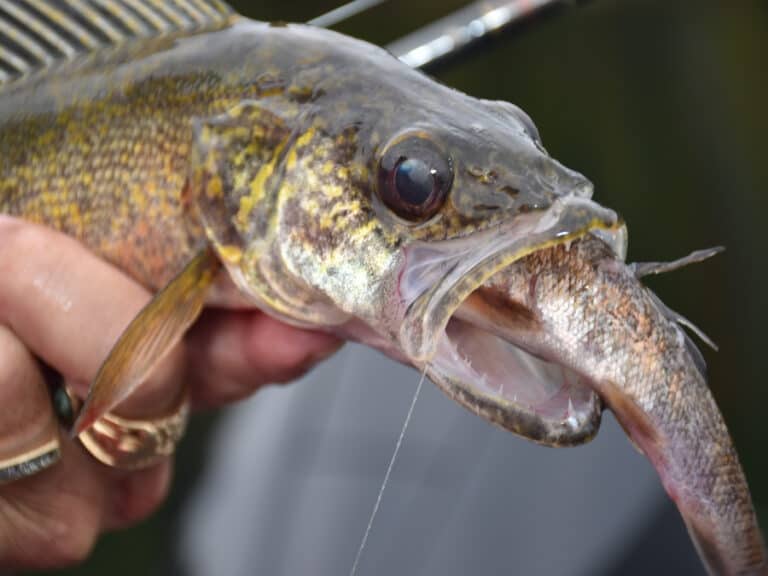Where to Catch Walleye: A Year-Round Guide
Walleye fishing can be good year-round but knowing where to find these fish can be difficult for many anglers.
Walleye are usually found in shallow areas during spring and fall and in deeper water near rock, ledges, and other structure during summer and winter.

Table of Contents
Seasonal Guide: Where to Catch Walleye
Spring
Head to northern shallow bays near creek inlets. Walleye will head here in early spring and remain until after the spawn concludes at the end of spring.
Early Spring: After ice out, look for walleye in shallower waters oftentimes in the northern bays of lakes where the first green vegetation growth of the year occurs. They will hold up in 15-20 feet over gravel or sandy bottoms.
These northern shallow bays will warm up first and draw a ton of baitfish like shad, alewives, shiners, and perch. Mornings and late afternoons until dusk will be the best fish time here.
Spawning Season: Just before the spawn, move towards the mouths of feeder streams and rivers. Walleye will stage at the mouths as they feed and prepare to move into the flowing water to lay eggs.
Once the spawn begins, find 5-20 feet depths in the river’s rocky or sandy bottom. Check your local regulations around fishing walleye during the spawn for legality.
Post-Spawn: Once the spawn ends, walleye will be hungry. This is one of the hottest times of the year to catch a lot of adult walleye. Walleye will push back out of the rivers into the main lake to the nearest drop-offs or ledges in water 10-25 feet deep.
If fishing in a river, look for deeper seams where a ledge or drop-off occurs. The best time to fish post-spawn is early morning and around sunset.
Summer
Walleye will move to deeper water around main lake points, inside turns, deep reefs and ledges, deep rock, and humps. In rivers, look for deep holes along seams and eddies.
Early Summer & Mid-Summer: In lakes, look for deeper water around ledges, drop-offs, humps, and deep reefs in water 20-30 feet deep. In rivers, look for similarly deep water around ledges or drop-offs along seams and eddies where the current is a little slower.
Look even deeper in mid-to-late summer as the water keeps getting warmer. 30-40 feet of depth is the ideal walleye depth in mid-summer.
Early morning and late evening until after dusk are the best times to fish for early summer walleye. For mid and late summer, the night can offer the best fishing if it’s a new or full moon.
Fall
Walleye gear up for winter in the fall, feeding heavily. Fish in shallower water near points, ledges, and humps as walleye will follow schooling baitfish.
Early Fall: Early fall is one of the best times of the year to catch a lot of walleyes. It’s my favorite time by far. Walleye will feed heavily this season as they gear up for winter. They will be packing on fat stores chasing schools of shad, alewives, perch, and ciscos.
Look for underwater structure like rock, or ledges in 15-25 deep in lakes. In rivers, focus on deeper seams with slower current. Early morning and late afternoons are the best times to fish in early fall.
Mid-Fall: As fall moves along, walleye follow the baitfish into shallower water. In lakes, look for underwater structure or sunken timber in about 10-20 feet. Look for eddies or slack water behind large boulders in the stronger river current.
Walleye will pour into these large eddies and chase baitfish that are starting to die off. The best time of day to fish mid-fall is late afternoons until dusk.
Late Fall: Walleye exhibit transitionary behavior in late fall and stage for winter. As the temperatures drop, look for walleye in deep holes in rivers and the deepest holes in the main lake basin. Depths of 30-50 feet deep is very common.
Ledge, drop-offs, and underwater rock are great. Underwater rock is especially awesome during winter as the deep rock will be slightly warmer than the surround water. Early to late afternoon is the best fishing time.
Winter
Find walleye in much deeper water, often with their bellies on the bottom. Look for main lake and river humps, ledges, and rock in deep water.
Early Winter: Walleye will remain fairly deep in 25-40 feet deep waters. Underwater features like rock, boulders, flooded roadways, ledges, and humps in main lake basins will be great to focus on. Walleye will associate pretty tightly with these features in winter.
Late afternoon until an hour after dark is the best time to catch walleye in early winter. I really like fishing during this time slot before or after full ice cover.
Mid-Winter: Walleye be be found way down deep in 30-50 feet of water if available in a lake. In rivers, look for the deepest holes in seams or eddies where the water will be warmest. Fish will hold very tight to the bottom, often with their bellies on the bottom.
Sandy or gravel bottoms are especially attractive in rivers. Early morning and late afternoon are the best times of day in mid-winter are best.
Late Winter: As winter tails off, walleye will start moving shallower to northern shallow bays where the water will warm first and vegetation will start growing shortly. Look for sandy or gravel areas over 15-25 feet of water around underwater structure.
Walleye fishing will improve as walleye feed more in preparation for spawning in mid-spring. Dawn and dusk are good times to fish for these fish.
For a complete guide to where to catch nighttime walleye in lakes, check out this guide.
Finding Walleye in Different Bodies of Water
Creeks
The best seasons to fish for walleye in rivers is spring (when walleye come to spawn) and fall (when walleye feed in preparation for winter). Look for the deeper pools and holes in creeks, often 3-8 feet deep. Eddies behind rocks or sunken trees are great spots to fish.
Walleye will hunt creek chubs, suckers, minnows, and small trout mostly in creeks. Large insects and crayfish are great food sources, too. Smaller jigs and live bait are the best baits for creeks. The best times to fish walleye in creeks are early morning and late afternoon.
Small Rivers
In smaller rivers, spring and fall are the two best fishing seasons. Look for eddies, seams, deep holes, and underwater structure like ledges and rock. Walleye will push down to 5-15 feet of water above gravel or sand.
Crayfish and baitfish like suckers and minnows are the best-preferred food sources. Live bait is the best small river bait overall. Early mornings and late afternoons are the best times to fish small rivers.
Large Rivers
Large rivers are great to catch walleye in all year long. Expect walleye to be deep in pools and seams during the daytime. They will be in about 20-40 feet of water. At night, walleye usually push shallow both vertically in the water column and towards the banks into water 10-20 feet deep.
Seams, current breaks, and ledges are great spots to look at. Sunken timber near deep water can be a great spot, too, as it will attract baitfish and crayfish. Early mornings are typically the best times to fish large rivers.
Ponds
Walleye fishing in ponds can a ton of fun. They don’t have many places to hide and usually don’t see fishing pressure. Spring and fall are the prime seasons to catch walleye in ponds. Look for the deeper edges of weeds and pads.
The earthen dam portion of ponds can be great year-round. If there is deep rock or dropoff in the pond, those can also hold good walleye numbers. Look for water 5-15 feet deep. Many state laws limit digging holes with special permits deeper than 15 feet so you won’t find too many man-made ponds deeper.
Nighttime and early mornings are great times. Look for surface action of baitfish action to know where to throw your baits. In shallow ponds, you’ll see a lot of the action.
Small Lakes
Like ponds, large lakes are typically good for walleye action all year. Focus on deeper water in summer and winter with fall and spring seeing shallower habits. Underwater structure and rocky shorelines are great sites to fish.
Cement dams are fantastic for walleye especially in winter when walleye push down to the deepest depths. Fish in water 10-25 feet deep. At night, walleye will move shallower near emergent weedlines.
Big Natural Lakes
In larger lakes, look for deep structure down 20-40 feet. Humps, reefs, ledges, drop-offs, and rocks can be good summer and winter locations. Look for the same structure in 10-20 feet of water in fall.
Check for diving bird like cormarants and loons for signs of baitfish. Trolling with deep crankbaits around dawn and dusk is one of my favorite methods.
Reservoirs
Big water like major reservoirs offer great walleye fishing year-round. Fall and spring will see walleye shallower in water depth. Focus on anything from 10-20 feet in fall and spring especially near river mouths. Inside turns near these mouths will offer good fishing during the day. During summer and winter, find deeper inside turns near main lake points.
25-40 feet are going to be a great range in many reservoirs to fish at. Deep rock near long main lake points are great winter walleye locations. At night, walleye will push closer to shore rising as the baitfish school do.
Great Lakes
In Great Lakes such as Lake Erie and Lake Huron, walleye fishing is good all year but locating walleye in huge water like this is the real challenge. Like other lakes, walleye move deeper in summer and winter but shallower in the shoulder seasons.
In summer, look for 30-60 feet depth for underwater features like humps, reefs, and rock. They also love transitional zones where sand meets gravel. Deep trenches and shipwrecks, if you can find them are some of the best big water structure you can find.
These are great walleye fishing spots. Trolling is probably the most effective ways to find walleye here. I love using baits that mimic smelt and alewives. Fish early in the morning and late afternoon for the best fishing.
Daily Movements & Spots
Time of Day
Table: Where to Find Walleye Throughout the Day
| Time of Day | Preferred Depth | Key Features | Preferred Substrate |
|---|---|---|---|
| Morning | Shallow to Mid | Near underwater vegetation, inlets | Gravel, sand, rocky bottoms |
| Midday | Deeper | Drop-offs, deep underwater humps | Mud, deep rock formations |
| Afternoon | Mid-depth | Sunken islands, underwater ridges | Sand, gravel |
| Evening | Shallow | Near shorelines, feeding grounds | Gravel, sandy areas |
| Night | Very Shallow | Shallow flats, near shore structures | Soft mud, sandy patches |
Weather Impacts
Table: Where Weather Moves Walleye
| Weather Factor | Preferred Depth | Key Features Sought Out | Notes |
|---|---|---|---|
| Bright/Sunny Day | Deeper | Underwater structures, shaded areas | Walleye avoid bright light and will seek deeper waters. |
| Overcast/Cloudy Day | Shallow to Mid | Near vegetation, underwater ridges | Walleye are more active and will roam more freely. |
| Rain | Variable | River mouths, inlets, drop-offs | Rain can wash bait into the water, attracting walleye. |
| Wind | Windward Shores | Windblown shorelines, shallow flats | Wind stirs up the water, often making walleye more active. |
| Temperature Drop | Deeper | Deep underwater humps, cooler areas | Sudden cold can send walleye to deeper, stable temps. |
| Temperature Rise | Shallow to Mid | Sunken islands, shallow flats | Warm weather can increase walleye’s metabolism/activity. |
| Barometric Pressure Drop | Mid to Deep | Near underwater vegetation, drop-offs | Dropping pressure often makes walleye less active. |
| Barometric Pressure Rise | Shallow | Near shorelines, feeding grounds | Rising pressure can trigger increased feeding activity. |
Moon Phases
Table: Moon Phase Impacts on Fishing Locations
| Moon Phase | Time of Day | Preferred Depth | Key Features Sought Out | Best Fishing Times |
|---|---|---|---|---|
| New Moon | Daytime | Deeper | Deep underwater structures | Late afternoon and evening |
| Night | Shallow | Near vegetation, shallows | Midnight to early morning | |
| First Quarter | Daytime | Mid-depth | Underwater humps, drop-offs | Late afternoon |
| Night | Shallow | Shores, sandbars | After sunset | |
| Full Moon | Daytime | Deeper | Deep underwater humps, cool areas | Mid-morning and early afternoon |
| Night | Shallow to Mid | Brightly illuminated areas near surface | Midnight to early morning, especially on clear nights | |
| Last Quarter | Daytime | Mid-depth | Underwater structures, sunken islands | Early morning |
| Night | Deeper | Deep flats, ridges | Just before dawn |
Finding Walleye During the Spawn
Please check with your local laws regarding walleye fishing during the spawn. It is illegal in many locations.
Walleye spawn in the early spring when the water is 40 to 50°F. Walleye lay eggs on rocky or gravelly bottoms with good current flow, keeping their eggs safe and oxygenated.
These fish love shallow waters, mainly 2 to 6 feet deep, near river mouths or inlets. While strong currents attract them, they also hang out in calmer spots, like eddies.
Fishing during this time can be rewarding if you are persistent. Using slow jigs with minnows works best since walleye might attack out of protection. Fish near rock during the evening and night.

Ice Fishing Walleye Spots & Safety
Fish in deeper water during winter, usually between 15 to 30 feet. Look for underwater structures like humps, drop-offs, or sunken islands. Inside turns are one of my favorite ice fishing locations. While they might be less active during bright daylight, they become livelier during dawn and dusk, often moving to shallower waters. Fish-finding electronics are a must-have.
Safety is paramount when ice fishing. Generally, you’ll want at least 4 inches of solid ice for walking and fishing alone. But remember, ice thickness can vary. Areas near the shore, inlets, outlets, or where streams enter the lake might have thinner ice due to flowing water.
Also, the ice might be thinner if the lake has springs or areas where currents converge. It’s safer on ice that’s formed over calm, deep water. Always go fishing with a friend and take safety tools like ice picks, a rope, and a spud bar to check ice thickness as you move.
Pro Tips to Find More Walleye
- Bird’s Eye View: Birds diving can signal baitfish presence. Walleye often lurk below.
- Color Matters: On overcast days, try brightly colored lures; they can make a difference.
- Moon Glow: Walleye bite is strongest during a full moon. Night fishing becomes prime.
- Temperature Tells: Use a thermometer. Walleye prefer cooler waters, around 60-70°F.
- Wind Works: Wind can push baitfish, and walleye follow. Check windward shores.
- Check Inlets: Water flowing into lakes or reservoirs can attract baitfish and, in turn, walleye.
- Transition Zones: Areas where soft and hard bottoms meet can be walleye hotspots.
- Dusk & Dawn: The golden hours. Walleye are more active during these low-light periods.
- Deep in Midday: Walleye go deeper when the sun’s overhead. Probe the depths around noon.
- Wreck Wonders: In great lakes, shipwrecks can be magnets for walleye.
- Weed Edges: Walleye patrol the edges of weed beds, hunting for prey. Cast along these lines.
- Reef Relief: In large lakes and the Great Lakes, walleye often congregate around underwater reefs.
- Seek Springs: Underwater springs offer cooler water, attracting walleye.
- Rocks in Rivers: Walleye often rest behind big rocks or boulders in creeks and rivers.
- Mud Matters: In spring, walleye can be found over muddy bottoms with abundant food.
- Listen to Locals: Local bait shops often have the latest intel on walleye movements.
- Current Breaks: In flowing waters, walleye rest in areas where the current breaks, conserving energy.
- Night Glow: Use glow-in-the-dark lures or jigs for night fishing. Walleye are attracted to the light.
- Barometric Watch: Falling barometric pressure can stimulate walleye to feed.
- Silent Approach: Use an electric motor or paddle. Noise can spook walleye in shallower waters.
- Tail the Baitfish: Identify primary baitfish in your water body. Match your bait to them.
- Under Ice Insights: In winter, look for underwater structures. Walleye stay close to their food sources.
- Rainy Rewards: Light rain can stir up the water and bring walleye closer to the shore.
- Trolling Tactics: Change speeds occasionally. A sudden speed change can trigger bites.
- Depth Finder: Use electronics not just to find the right depth but also to spot schools of baitfish.
FAQ: Finding Walleye to Catch
What depth do you find walleye?
Walleye can be found at different depths, but they often like to stay in waters between 15 to 30 feet deep. The exact depth can change based on the time of day and the season.
What is the best location for walleye?
The best spots for walleye are usually near underwater structures like rock piles, sandbars, and drop-offs. They also like areas with moving water, such as river inlets.
How to find walleye in the winter?
In winter, walleye move to deeper parts of the lake or river. Look for walleye in deep holes in the 25-45 foot range with rock, ledges, and humps. Use electronics to find fish.
How to find walleye in small lakes?
In small lakes, look for walleye around sunken islands, weed lines, and shallow bays, especially during dawn and dusk when they come to feed.
How do weather conditions impact walleye location and behavior?
Weather plays a big role. On sunny days, walleye dive deeper to avoid light; they might come closer to the surface on cloudy or overcast days. After a rain, they often go to areas with fresh water, like stream mouths.
Are there specific underwater structures or areas where walleye are commonly found in a lake or river?
Walleye love areas with structure. This includes rocky bottoms, drop-offs, weed beds, and river bends. They use these spots to hide and hunt.
How do water temperatures influence where walleye might be in a lake, river, or reservoir?
Walleye are sensitive to temperature. When it’s warm, they’ll go deeper to find cooler water. They’ll move to shallower waters in cooler seasons to stay warm and find food.
Conclusion
Walleye fishing is greatly influenced by weather, seasons, and moon phases. In spring and early fall, walleye are found in shallow waters, especially near underwater structures, while they move to deeper waters in summer and winter.
Weather conditions, such as overcast days, bring them closer to the surface, while bright days push them deeper. Moon phases, particularly full moons, affect their nighttime activity.



